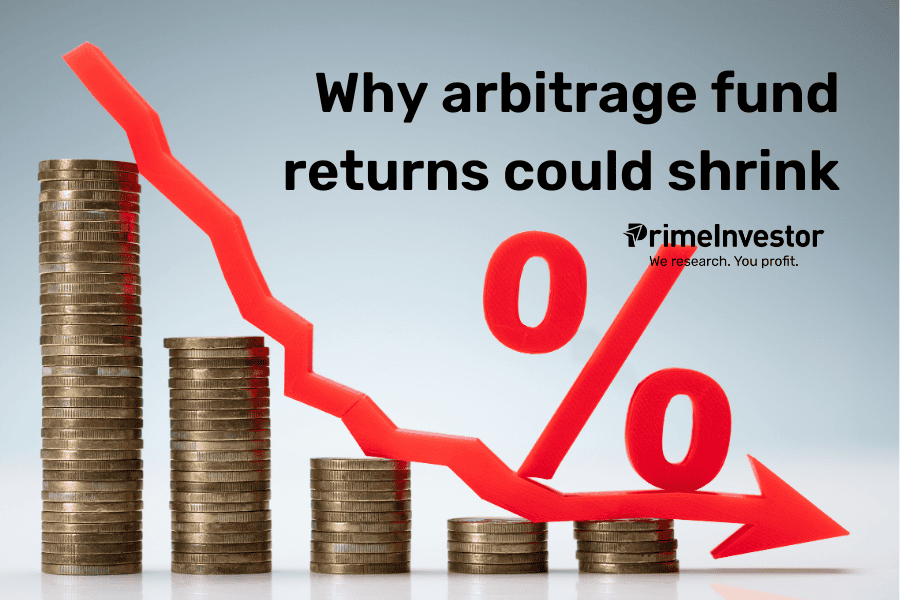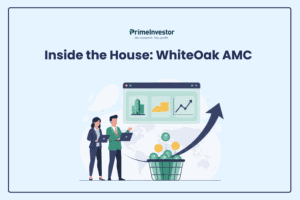As regulators launch an all-out offensive against retail trading in futures and options (F&O), it is not just those trading in derivatives who will feel the heat. Investors in arbitrage funds, a popular category of funds, may see a reduction in their returns too.

In the past, we have written a report explaining the relatively small edge that arbitrage funds have over short-term debt funds for investors looking at longer time frames. We see this edge narrowing further now. Here are four clear headwinds that could moderate arbitrage fund returns in the year ahead.
#1 Liquidity hit
In its consultation paper on F&O trading, SEBI has proposed a variety of measures to curb retail participation in this segment. Most of these measures target index options, which is where most newbie traders burn their fingers.
The changes proposed to the options segment – such reducing the number of weekly contracts, steeply raising margins for trades taken close to expiry day, rationalization of strike prices on options etc do not have any direct bearing on arbitrage funds, as these funds do not dabble in options. Arbitrage funds mainly earn their returns from the spread between monthly spot and futures contracts on stocks.
But there is one SEBI proposal that can significantly lower participation by individual investors in the futures segment. This is the proposal to sharply hike the minimum contract size for trading in F&O from the current Rs 5-10 lakh to Rs 20-30 lakh over a six-month period.
The hike in minimum contract value will require retail investors to raise their capital commitments manifold to participate in stock futures. To give an example, today a single lot of HDFC Bank August Futures (lot size 550 shares, price Rs 1,638) costs about Rs 9 lakh. To buy a single lot, the investor would have to fork out a margin of roughly Rs 1.5 lakh. If the minimum contract value were to be set at Rs 20 lakh, the lot size would go up to over 1220 shares, requiring a margin of over Rs 3.3 lakh even if margins are not hiked.
Therefore, it is quite likely that the higher margin requirements will prompt smaller individual investors to reduce their bets in the futures segment. Should they do this, liquidity in stock futures could take a material hit. NSE data shows individuals contributing 19% of stock futures volumes.
Individual investors are more active in buying stock futures (as this needs a lower margin) than selling them. Mutual funds looking to make arbitrage gains are large sellers of stock futures (they sell the monthly future and buy the spot to pocket their spread). As mutual funds may not significantly reduce their activity levels due to higher capital requirements (they have funds committed to this strategy), the sharp hike in contract sizes could lead to more sellers than buyers in stock futures, leading to lower spreads. The stock futures segment of the F&O market is already not very liquid, with only a few dozen stocks offering enough liquidity for institutional players. Lower retail participation can further shrink this pool.
This problem is aggravated by arbitrage funds being saddled with larger assets to deploy after receiving large inflows in the past year (due to unfriendly debt fund taxation). AMFI data shows assets managed by arbitrage funds more than doubling from Rs 93,046 crore in June 2023 to over Rs 2.08 lakh by June 2024. What’s more, many hybrid fund categories such as equity savings funds also play the arbitrage game to earn debt-like returns from equity bets.
Arbitrage funds could reduce their bets on the spot-futures trade and look for mispricing opportunities to earn their spreads. Such opportunities may, in fact, expand with lower liquidity. But this kind of arbitrage is likely to yield more volatile returns – not the clockwork-like returns that comes from spot-futures arbitrage.
#2 Higher taxes
Arbitrage fund survive on fairly thin spreads. Therefore, their returns are quite sensitive to transaction costs. The recent Budget has sharply pegged up the transaction costs for arbitrageurs by doubling the Securities Transaction Tax (STT) on the sale of futures to 0.02% from 0.0125% of the price. This is effective from October 1 2024.
That is for the fund itself. For you as an investor, you also will see a higher tax impact. Short-term capital gains tax on arbitrage funds (equity-oriented funds) has been hiked from 15% to 20%, which will hit your post-tax returns.
#3 Falling rates
Spot-futures spreads in the derivatives segment are actually a proxy for the cost of short-term money in the debt market. Therefore, such spreads closely track rates for short term debt instruments. With US jobs data signalling a slowdown if not a recession, there’s now a growing global consensus about the US Fed cutting rates starting September. Market yields are already reflecting this expectation. Should the US Fed embark on rate cuts, India’s Monetary Policy Committee will have to follow suit.
Market yield movements in India are already signalling this. The yield on the 10-year government bond in India has dropped from 7.2% in April to 6.9% now, while the yield on the 91-day treasury bill, a short-term benchmark has dropped from a recent peak of 7.03% to about 6.8% now. Falling rates in the overnight and money market are usually reflected in the spreads in the F&O market too.
#4 Choppy markets
The spreads that arbitrage funds make from spot-futures trades depend on the appetite that traders display for betting on futures. This appetite is highest when the markets are trending smoothly higher and traders believe in a high probability of profits. This appetite can evaporate in unpredictable markets with sharp two-way moves or in bear markets.
In India, retail traders have taken to F&O in big numbers only post-Covid when markets have displayed sharp upward momentum. However, there are now signs that the upward trending market can give way to more volatile trends or even a decline. A more turbulent global environment, the lack of positive cues from both the election results and the recent Budget and signs of fatigue in earnings trends suggest that Indian markets may now be entering a choppier phase. This too could reduce F&O spreads, and thus the returns made by arbitrage funds.
Bottomline
Going by the above factors, it appears that arbitrage funds may see their edge over short-term debt options reduce going forward. But to what extent these factors will play out will hinge on the final contours of SEBI’s F&O measures. We are primarily alerting you to keep expectations realistic when it comes to arbitrage funds given the recent developments. As SEBI inflow data shows many investors have increased their exposure to this category after the change in debt fund taxation from April 1,2023. Whether such a move will be beneficial for you needs to be watched. We will attempt a more data-driven comparative exercise based on actual returns once these factors begin to kick in.





14 thoughts on “Why arbitrage fund returns could shrink”
Having discussed on Arbitrage would be interested to have your views on Debt funds post Budget as wells as Hybrid
On Debt and hybrid, we have written in detail about them.https://www.primeinvestor.in/reports/budget-2024-equity-and-debt-investments-taxation/ the tax change will not impact the fund’s returns. it only impacts your own returns in some cases. Arbitrage is different. The proposals may impact the category’s returns.
So now what is the suggestion for Short term for someone in highest tax bracket? Going back to FD’s?
It depends on your return need. We are only saying the high return expectation on this category should be tempered if he proposal becomes a reality. Vidya
Hi Mam, my understanding was that if the markets are more volatile, option premiums are usually higher, then there are chances for better returns right? Does the decrease in appetite outweigh this?
It’s true that seasoned traders can make the most of volatility. But in India there’s so much uninformed retail trading in options that a two way market may lead to many investors making losses and exiting. The problem is the trending market with low volatility that has been the norm since COVID. This is when retail activity has surged!
Thanks a lot for this article. I think a lot of other fund categories will also take a hit. For ex Equity savings uses a lot of arbitrage to keep equity at 65%. Most hybrid funds, especially those that have taken a call on lower equity (for ex ICICI BAF and SBI BAF are both close to 30% net equity) will depend on arbitrage to qualify for equity taxation to hit 65%.
Helios BAF hardly has the debt component like other BAF’s do. They only have some 10% debt exposure and the rest on arbitrage as they think its a better bet than interest rate risk of GSEC and bonds. Now all this contra thinking will take a hit assuming things play out for the worse for everyone.
Yes good observation. Such funds may need to move to pure debt exposure in place of arbitrage!
Thx. Good observations on the volume shrinkage and transaction cost increasing.
I am curious to understand your statement on mispricing. Isn’t mispricing based on fundamentals showing a different value compared to the trading value. Would this not become a long game (almost like a value fund)… Or is there some other interpretation of mispricing that you are refering to.
Just as we saw a large inflow in the last year, maybe this will result in a significant outflow (as the new way kicks in) and a higher equilbrium may be reached after the initial significant fall… As you said will have to wait and see.
Thank you. By mispricing here I refer to stock futures trading out of sync with spot or market spreads due to lack of depth. There can also be mispricing when futures prices don’t correctly adjust to events like dividend or bonus or corporate actions bcos of poor liquidity. It very possible that poor returns will drive HNIs out of the category and restore balance 🙂 but the path to.this equilibrium may be very bumpy!
Hi Aarati,
Extent of effect on equity saving funds? What’s more advantageous now for moderate investments – Aggressive Hybrid or Balanced Advantage funds with dynamic asset allocation?
Thanks
Rajiv
This will affect returns on the arbitrage portion of equity savings funds which are used to make up the 65% equity component. Hard to quantify right now as the f&o changes are still in consultation stage. But balanced advantage and dynamic will be better placed as they have greater flexibility on asset choices.
In other words, the ‘arbitrage’ of equity taxation with reasonable returns comparable to short term debt might be reducing. Be ready for more risk with net equity or a tax hit with more debt.
Well said!
Comments are closed.